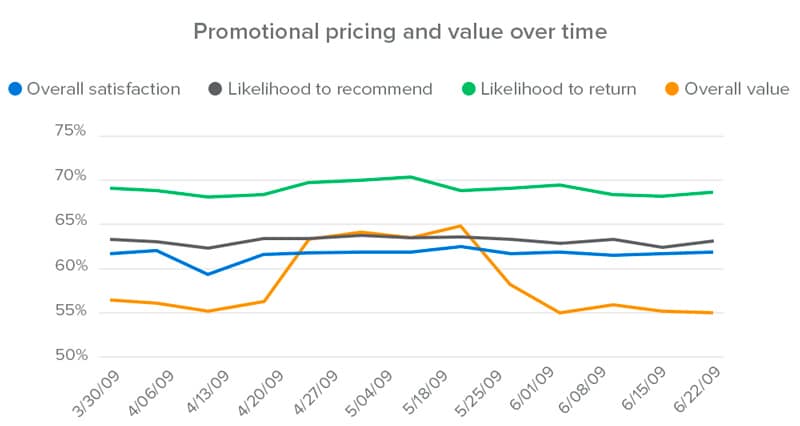How You Can Deliver Value and Address Rising Food Costs for Restaurants
Published on May 25, 2022

After two years of COVID concerns, many hoped things would get easier in 2022, but a collection of new and lingering issues are leading to rising food costs for restaurants. No single industry, company, or business is addressing these issues in isolation, so the question becomes, “How do you make the most of what you can control?”
Here we provide some background into what is driving these recent challenges and insights for how to address rising food costs for restaurants by focusing on value perceptions, customer satisfaction, and staff efficiency.
Why Are Restaurant Prices Increasing?
2022 is turning out to be a perfect storm for the restaurant industry. In the midst of still figuring out how to completely recover from the challenges of the last two years, labor issues that were already exacerbated by the pandemic continue to contribute to staffing challenges. In addition, lingering supply chain issues are dramatically increasing shipping times and expenses while the highest levels of inflation in decades are further contributing to rising food costs for restaurants. As an industry at the very end of the supply chain, restaurants are left to contend with the simultaneous combined impact of these headwinds.
What Food Costs Are Rising?
The most recent look we have into what food costs are likely to do for the year is a U.S. Department of Agriculture March 25 report of their outlook for 2022. According to that report, food-away-from-home prices are expected to rise between 5.5 and 6.5%, driven by over 12% increases in meats like beef, pork, and poultry, an 11.7% increase in fats and oils, and a 7-10% increase in fresh fruits and vegetables.
Will Costs Go Down Soon?
The prices restaurant operators pay for food items is dependent on a vast, interconnected network of industries and systems. This includes everything from logistics chains that run from the farm to the store, to farm supply chains that are being affected by the Ukraine crisis—since Russia is a major exporter of industrial fertilizers. It should be expected that prices will continue to be high at least through the end of the year, and it remains to be seen what effect the recent interest rate from the U.S. Federal Reserve will have on helping to control general inflation.
Research-based insights on how consumer spending will trend in 2022
How to Deal with Rising Prices
Unfortunately, there’s nothing owners can do about the prices they pay when it comes to rising food costs for restaurants. What you can do is stay laser focused on what you can control. One key area of focus should be to improve customer perceptions around value and satisfaction independent of price. Another is to engage with your staff to make the most efficient use of the people and resources available. By being as conscientious as possible at this volatile time, you can set yourself up to emerge from this period in as strong a position as possible
Deliver Value Amid Rising Costs
The good news is you’re not alone. With inflation and supply chain issues affecting every industry, there’s upward pressure on costs—and prices—across the board. However, if we learned anything from the 2008-2009 financial crisis, it’s that long-term success in times like these isn’t driven by price, it’s driven by your customers’ value perception and satisfaction.
What Does Value Mean to Customers? Is it Just Price?
When it comes to how customers feel about what they pay at your restaurant, to limit your thinking to the price of an item ignores the extensive work that you put into the rest of the customer experience.
After all, nobody’s buying a Bentley just to get a car.
The value of your product is not limited to just pricing—it encompasses the entirety of the customer experience, from the first time someone searches for you online, to the branded app that tracks their customer loyalty points when an order is placed. Boiled down, “value” is the satisfaction people feel from a purchase or interaction relative to the price they paid.

Obviously, you can improve value by reducing cost, but that comes with complications we’ll address shortly. It’s smarter to focus on the litany of elements affecting satisfaction on the top part of the above equation besides what you serve customers, including:
- Speed or efficiency of service – Distribute staff and use technology in a way to serve customers as quickly as possible and be sure to make good on time commitments you make for food delivery.
- Quality of service or attention paid to the customer – Making sure to deliver on service doesn’t cost extra, and engaged employees who look to delight customers are your most valuable assets to this end.
- Customer brand loyalty – This is where the extensive effort your team has put into building a reputation will pay off by simply continuing to do what you do.
- How well the restaurant delivers on the product as promised – Consistently make good on the commitments you made above to naturally drive higher satisfaction and loyalty over time.
- Offering reliable, high-quality delivery options – You can do a lot to expand your potential market thanks to the expansion of third-party delivery options, as long as you can ensure a good customer experience.
By determining what these elements mean for your customers and working with your teams to address these non price-related aspects of the customer experience, you can drive up value sentiment (or at least keep it stable) despite the need to increase menu prices.
Beware the Price-Value Trap
With inflation on the rise and the possibility of price increases industry-wide, the temptation is to find ways to give discounts to attract customers and improve value perceptions. Be warned, as this solution not only has a very limited impact, but—based on research SMG conducted in the 2008-2009 financial crisis—it actually hurts value perception in the long run.
For example, where a brand offered lower prices as part of a promotional offering, data showed that value perception did increase during the promo, but it resulted in no significant impact on overall satisfaction. Then, after prices returned to normal, not only did value perception quickly fall, but the scores were actually slightly lower than before!

In addition, our research showed customer satisfaction was a much better indicator of likelihood to return, and a customer with a low value perception and high level of satisfaction was still more likely to return (68%) than a customer with a high value perception and low level of satisfaction (54%).
All this illustrates how customer satisfaction trumps even value in keeping customers coming back; so focus on satisfying customers first.
Use Predictive Insights
Make a special effort to determine what is driving customer decisions and how you might be able to proactively meet customer needs and expectations while strategizing how to address increased costs. For example:
- Would customers be interested in seasonal items, which may be able to take advantage of more affordable ingredients?
- Are customers buying more combos to try and save money, or are they purchasing single menu items?
- Can you suspend lower-popularity menu items to keep from having to source and stock your inventory variety?
Understanding how customers are shopping your menu—not just how they’re purchasing—can help you plan, price items or bundles more effectively, and tailor your upselling opportunities and special offers.
Deliver Quality Experiences
Being able to consistently deliver on your commitments is its own gift, and every interaction a customer has where you deliver on expectations helps build loyalty. There are a number of strategies—independent of pricing—that can help make sure your customers have a consistent experience that meets their expectations regardless of the interaction channel or location. Our research from hundreds of clients has demonstrated customer behaviors around loyalty, like willingness to return or recommend, have the strongest links to sales growth.
Identify Key Loyalty Drivers
Think about the brands you love the most—the ones you’ve been going back to for years. Chances are, for the most part, what keeps you coming back isn’t the price. Price and convenience are the lowest loyalty motivators, so you need to lean in hard on what it is for your brand that keeps loyal customers coming back. Using CX data and insights is a great way to not only determine what these key drivers are, but also to continually assess the effect your efforts have not only on customer sentiment, but sales over time.
Maximize Staff Efficiency
With the ongoing labor shortage, staffing continues to be an issue in the restaurant industry, and since it has yet to be seen how labor issues will be resolved in the long run, you must make the most of what you have available. Our extensive research and experience with the concept of the Service Profit Chain has shown the strong correlation between employee satisfaction, customer loyalty, and financial performance, so keeping your staff engaged and happy is a key path forward. Here are some strategies for addressing employee needs:
- Engage with staff for their input on scheduling and use resources to plan proactively and realistically to avoid staff burnout or paying for redundant labor.
- Turnover and short staffing are running high, so consider strategies that will help streamline employee training and improve efficiency to make it easier to deliver on consistency.
- Embrace digital tools, like branded apps and ordering kiosks, letting customers choose their own ordering channels and increasing efficiencies to reduce staff demand in certain areas and improve overall costs in operations.
Use Business Intelligence for Insights
You lose valuable time using trial-and-error to try and guess what your customers or employees want. Having an experience management solution in place to collect and analyze feedback will help you get to the core of your customers’ expectations and wants faster so you can work on iterating solutions.
Delivering on these aspects can help your team members focus on what can be controlled to mitigate the economic pressures of rising food costs for restaurants and help secure long-term stability.
Related articles

Driving Brand Loyalty for Restaurants through Value-Focused Offerings
Consumers are cutting back on spending and “value” has become the name of the game—especially for the restaurant industry, which is taking one of the biggest hits. A recent SMG study showed nearly 70%

Consumer Behavior Trends: Spending Habits in 2022
As of last June, 81% of Americans owned a smartphone. In the throes of this convenience revolution—as more consumers turn to their phones for research and to make purchases—the pressure for brands to

Why You Need to Keep Refining Your Digital Customer Experience
As of last June, 81% of Americans owned a smartphone. In the throes of this convenience revolution—as more consumers turn to their phones for research and to make purchases—the pressure for brands to